I had several vivid expectations about Berlin.
While it’s true that sausages are hiding around every corner, decades of consuming mass media led me to believe northern Germans are uptight and lack a sense of humour. But after a few days in Berlin, I realised how wrong I was.
Berlin felt edgy and progressive while being refreshingly organised (I had spent the previous weeks in Greece and Turkey – yikes!). The vast majority of Berlin’s residents I bumped into were thoughtful, considerate, and demonstrated a decent level of empathy.
Or maybe just anywhere compared to Istanbul seemed like heaven. I don’t know.
I jokingly said that I’ve always wondered what a city full of people like me would be like. And now I know.
It’s called Berlin.
Berlin struck a chord with me. It felt like home. And not just because of Germanic family heritage from the 1800s. Or because of my unnatural obsession with electronic music, although that helps.
It was the vibe.
That’s the only way I can describe it. And I’ll admit it’s a pretty sucky way to describe it to someone who hasn’t been there. So I’ll expand with the best practical advice I can share for first-time visitors to Berlin. And then, hopefully, by the end, you’ll catch the vibe too.
Essential reading: If your trip to Berlin will be part of a larger trip around Europe, check out my essential guide on how to plan a trip to Europe.

How To Save Money in Berlin
Although geographically located in central Europe, I expected Berlin to have a similar cost of living to other major western European cities like Paris, Brussels, Amsterdam, and London. Nothing could be further from the truth.
Food, transport, and accommodation were all significantly cheaper. I figured this was too good to be true, and there had to be a catch. But there wasn’t. However, that doesn’t mean you should spend frivolously on your first trip to Berlin. Make your money stretch further with these practical tips.
Use Public Transport
Day passes for public transport cover trams, trains, metro lines, and buses. As long as you make at least 3 trips per day (very easy when sightseeing), then you’ll save money. 24-hour tickets for the AB zone are just €8.80, while 7-day tickets are €36. Tickets can be purchased from automated machines, which accept cash or card, at most train and metro stations.

Free Self-Guided Tours
If you’ve got time to stroll and prefer to do things on your own, download the MP3s and PDFs for Rick Steve’s free audio guide tours. He covers a detailed walk from the city centre to east, touching on many essential attractions for first-time visitors to Berlin.
Supermarkets are Your Friend
Eating out in Berlin is cheaper than in other western European cities. However, when on a budget, every Euro counts. It’s better to make your own breakfast from supermarket ingredients and save your food budget for enjoying lunch and dinner at restaurants and street food vendors.
Tip: Remember to bring your reusable shopping bag. It’s good for the planet and your pocket.
As a vegan, I was in heaven when I discovered the plant-based supermarket Veganz located near East Side Gallery. They stock over 2,500 plant-based items, including 70+ meat alternatives and 80+ cheese alternatives. I looked like a wide-eyed kid in a candy store.
In addition, several bio/organic supermarket chains are sprinkled around Berlin: LPG, Bio Company, and Denns, with dozens of locations between them. Entire refrigerated sections are dedicated to plant-based foods and ingredients. I picked up breakfast at an LPG location and went a little overboard with the vegan pastries… whoops!
While the major supermarket chains include REWE, EDEKA, ALDI, Lidl, as well as some smaller players. It’s still very easy to find healthy meal options here too.
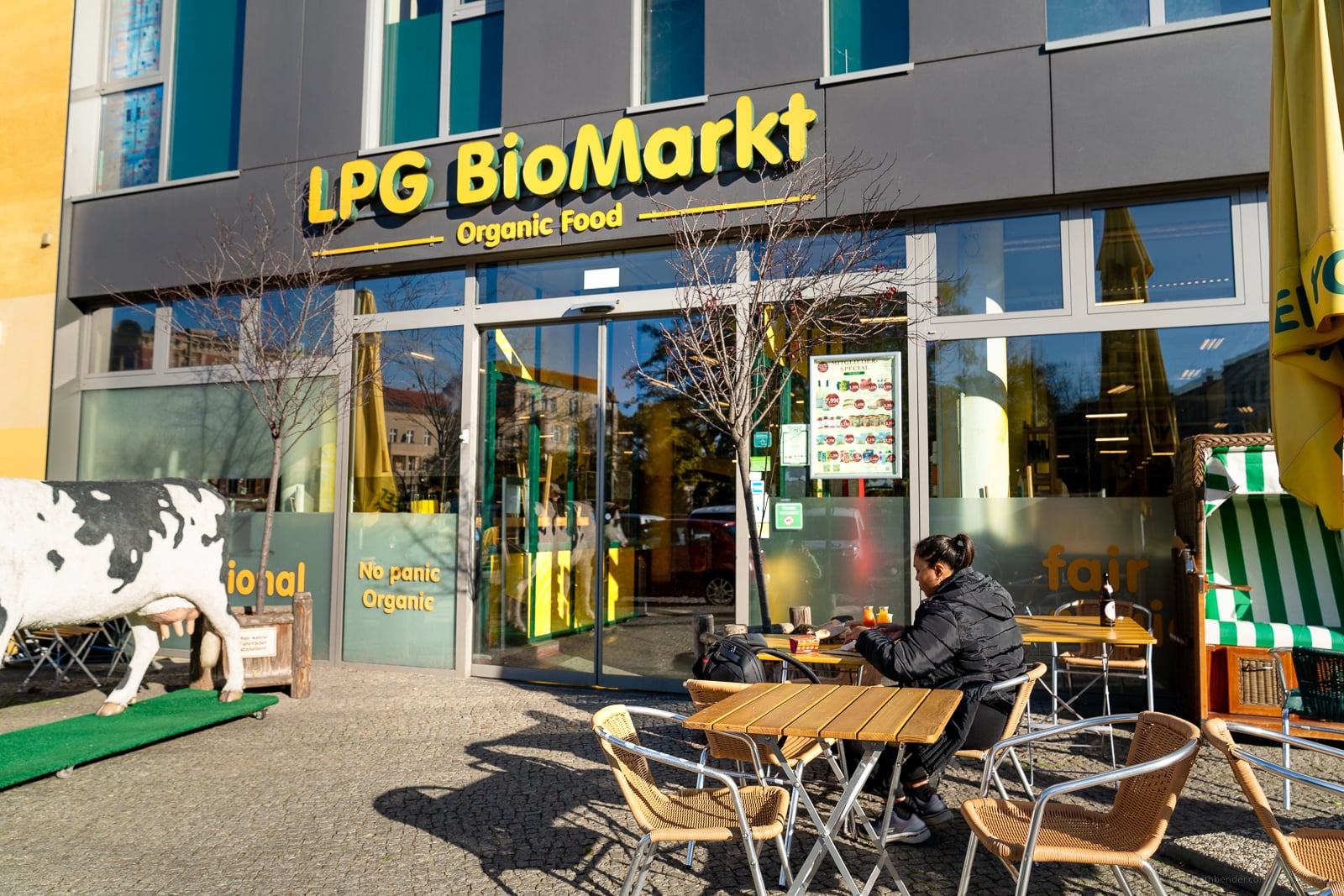
Berlin Welcome Card
This official discount card from Visit Berlin (Berlin’s tourism board) includes free unlimited public transport and discounts for over 200 sights and attractions. Not to mention a comprehensive map and guidebook. Pricing is based on validity length and zones. There are 2 zones: AB or ABC, with the first including the bulk of attractions in central Berlin (what most people will need), and the second including surrounding regions of Potsdam and BER airport. Available validity lengths are 48 hours, 72 hours (with or without “Museum Island”), 4 days, 5 days, and 6 days.
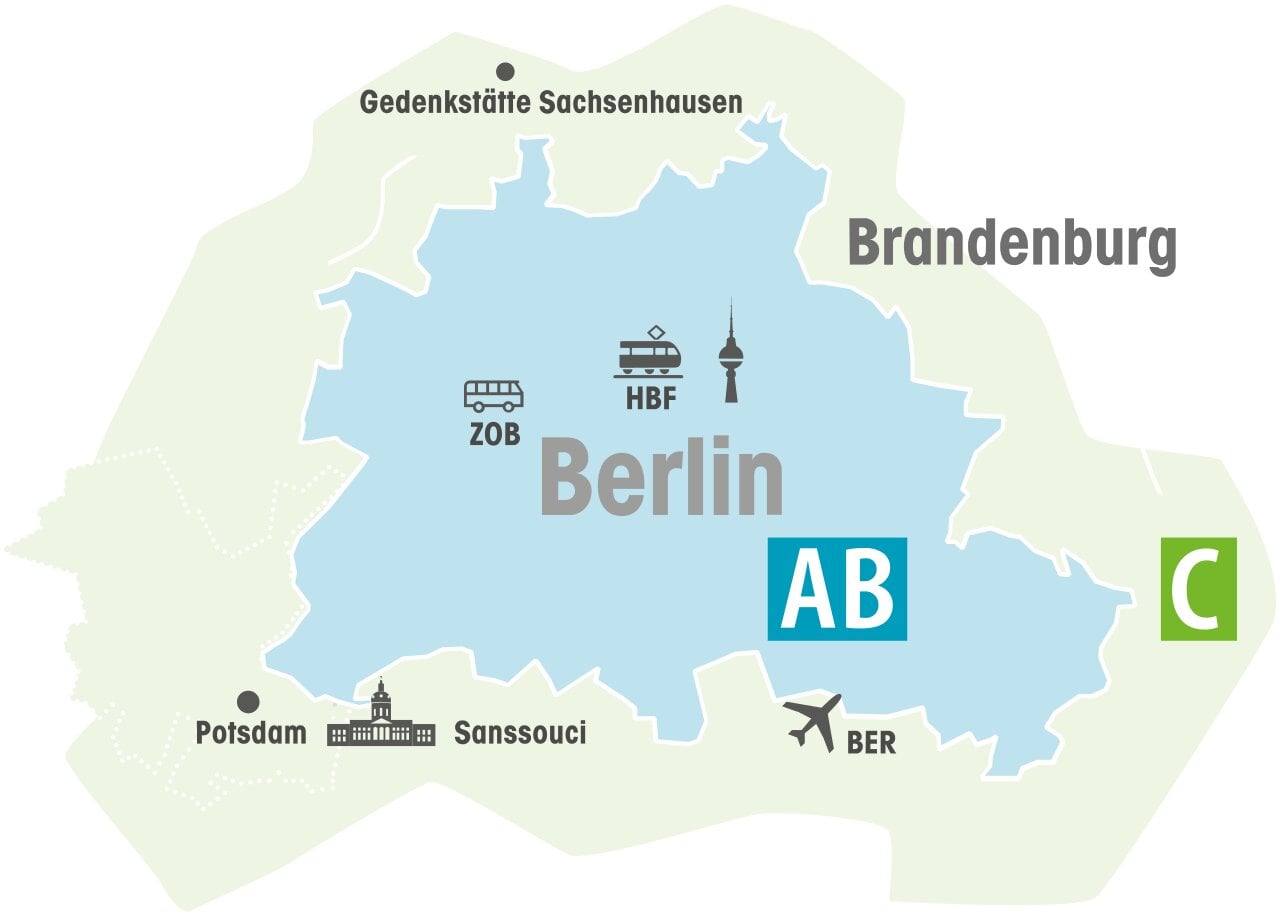
Or, if you want a complete solution, they offer an “all access” version of the card, which includes free entrance into 30+ attractions plus a free 1-day hop-on-hop-off bus.
The Berlin Welcome Card can be purchased via the official website in a digital format (PDF), or posted to your home. The PDF version must be printed and carried with you on public transport in case it is requested by a ticket inspector. If you forget to buy online, the Berlin Welcome Card can be purchased at Berlin airports, many hotels, some train ticket machines, and the conveniently-located Visit Berlin tourist info centres.
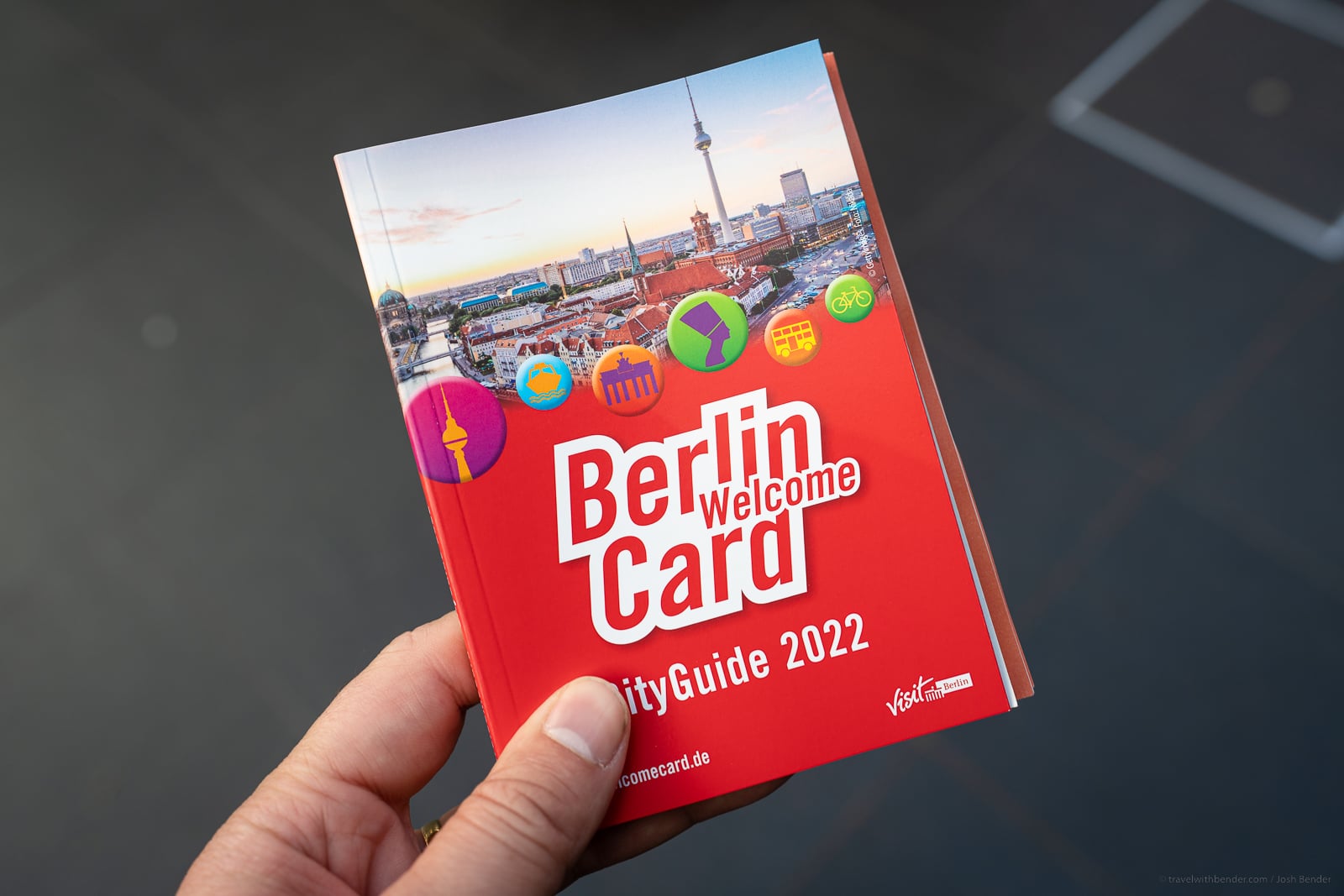
Money Tip: 1 ticket includes unlimited public transport for 1 adult PLUS up to 3 children (6-14 years old). Children under 6 are free.
Berlin Tip: The 48 and 72-hour versions are valid for exactly 48 or 72 hours from initial activation. However, the 4, 5 & 6-day versions are only valid for whole calendar days until midnight of the last day (from validation). Eg. If a 4-day card is first used on Tuesday morning, it’s valid until Friday midnight. So plan your sightseeing schedule to make the most of the available time.
Sightseeing Tip: If you’re a history and culture buff, and just plan on focusing on Berlin’s museums, then an alternative is the 3-day Museum Pass which includes free entry to 30+ museums (including Museum Island).
Getting Around Berlin
Walking. This is Europe, and you’re going to do a lot of it. Berlin is an extremely pedestrian-friendly and bike-friendly city, but major attractions are spread over a significant distance (from Kurfürstendamm shopping district to the East Side Gallery is 9.4 kms). I easily racked up over 15,000 steps daily on my Galaxy Watch, so wear comfortable walking shoes and socks (these are my favourite socks).
Etiquette tip: You typically cross the road at a designated crossing when the light is green OR there is no traffic around. Berliners can be a stickler for rules, and I found that they only cross on the green light. The logic is that if you can’t follow those basic rules, you’re more likely to break bigger ones. Fair enough.
Public transport is convenient and fast, although traffic jams can affect buses and trams during peak times. Buses, trams, and trains are generally punctual – as you would expect in Germany (although some Berliners will disagree). The government’s goal is to make 80% of journeys possible on public transport – and they’re making significant headway on that.
The central Hauptbahnhof (sometimes abbreviated to “HBF”) is a futuristic train station, with dozens of useful shops and delicious restaurants. The design is both beautiful and highly functional. I dare say it’s the best train station in Europe. The only fault was that there weren’t enough self-serve luggage storage units.
Using a multi-day public transport ticket (such as the one included with the Berlin Welcome Card - above), only needs to be validated the first time it’s used, and can be used across all public transport networks.

There are several transport networks to get familiar with:
- U-Bahn (subway) – 173 stations connected by 146 kms of track. Most tracks are underground, although there are a few above ground too. Station signage contains a blue and white “U” symbol. It operates from 4am until 1am on weekdays and 24 hours a day on weekends. During peak times, trains run every 3-5 minutes, and 10 minutes during the day, whilst every 15 minutes at night. Download the PDF network maps from the official website.
- S-Bahn (light rail) – 170 stations connected by 330 kms of track. The network stretches from central Berlin to the surrounding region. Station signage contains a green and white “S” symbol. It operates from 4:30am until 1:30am on weekdays and 24 hours a day on weekends. During peak times, trains run every 10 minutes, and between 10-20 minutes off-peak. Plan your journey or view the map on the official website.
- Buses – 150 lines crisscross the capital. Day buses run from 4am to 1am, while MetroBus lines (starting with the letter “M”) M11 to M85 run 24 hours in 10-minute intervals. Night buses run from midnight to 4:30am and leave every 30 minutes.
- Trams – Running across 22 lines, the tram network is more heavily focused on east Berlin. It operates 24 hours a day, with Metrotrams (indicated by “M” in the line name), running at a high frequency. This was my favourite way of getting around Berlin with more time to take in the views.


Taxis & Rideshare are a little expensive, and not necessarily any faster than the metro, especially during peak hours. The most popular e-hailing apps are: Uber, Bolt, Free Now, BlaBlaCar, Talixo, CleverShuttle, Drive2day,
There’s no shortage of e-scooter options in Berlin. These will suffice over shorter distances and can be a lot of fun. If you want to feel the air in your hair, the most popular options are: Lime, Bird, Bolt, Tier, and Voi.
Note: You’re not allowed to drive electric scooters on sidewalks in Berlin – fines may apply.

Bike sharing is an environmentally-friendly option, with many bike paths around Berlin and safer road conditions than most major cities. Leading providers are: Tier, Nextbike, Bolt, LimeBike, and Donkey Republic. And full-sized scooters are available from Felyx, Tier, and Emmy.
Driving. Compared to other European cities, Berlin is very drivable. But for short-term visitors renting a car can be a little pricy just for getting around town, not to mention parking costs. If you’ve got 4 or more in your travel group, then driving can work out cost-effective, especially if you’re trying to cram a lot of sightseeing in just a few days. Either choose a traditional car rental agency or car-sharing platform like: WeShare, Share Now, Sixt Share, Miles, and cambio.
Getting to Berlin Brandenburg Airport (BER) is fast and painless even though it’s 40km south of the city centre, near the city limits. The spacious Airport Express (FEX) train runs from Hauptbahnhof central station to terminals 1-2 every 20 minutes, and only takes 37 minutes. The S-Bahn connects directly to terminals 1, 2 & 5 (where all flights depart from). Interconnecting light rail or buses join the remaining terminals. And a dozen bus lines connect the airport to locations all over Berlin as well as surrounding cities like Potsdam. Train tickets can be purchased from automated vending machines – no need to pre-book.
Essential Tours in Berlin for a First-Time Visitor
Spree River Cruise
Drift along the waterway that snakes through the centre of Berlin on the top deck of a Stern + Kreis boat. Over 1 hour, you’ll see a dozen sights, including Berlin Cathedral, Nikolaiviertel, and government district. An audio guide is available in 12 languages, which explains the significance of each major sight, peeling back layers of Berlin’s history. During peak season, there are 3 pick-up points, but I recommend Nikolaiviertel Pier, which has a ticket booth metres away and is within walking distance of the UNESCO World Heritage site, Museum Island.
Hop On Hop Off Bus Tour
This tour, operated by City Circle, includes a recorded audio guide in 20 languages and operates every 15-20 minutes, so you’re never waiting long for the next bus. Covering 22 stops over a period of 2.5 hours, you can get a very detailed overview of Berlin without having to break a sweat. Book online with a discount code “20BOB” to save 20%.
Tip: Berlin city council does not allow highly visible bus stops for tourist buses to avoid spoiling the streets' aesthetic. So you need to pay close attention to the bus map or website, and look for the bright yellow bus with pink lettering.
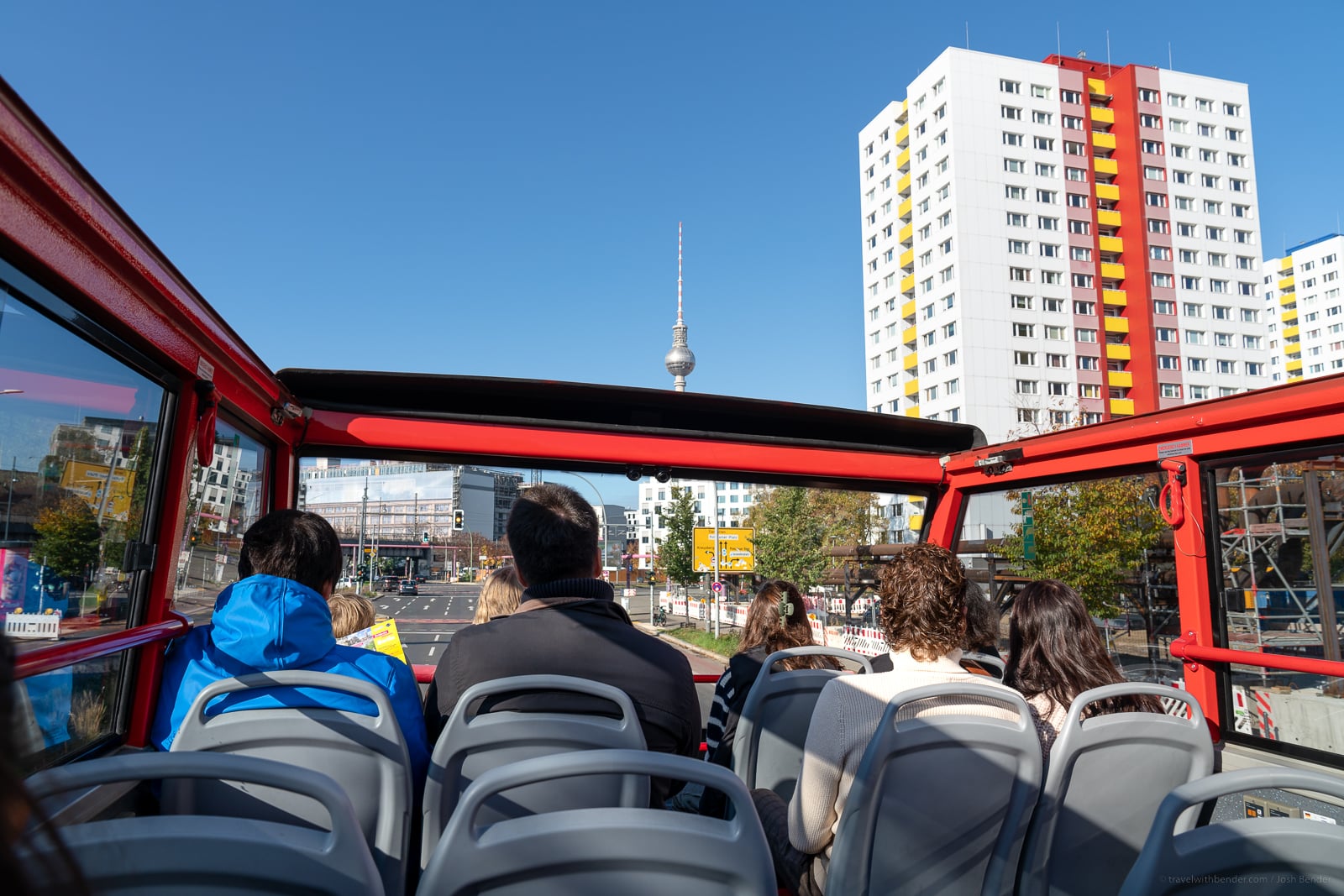
Vegan Food Tour Berlin
Berlin is a vegan food-lovers paradise, from the wide range of international cuisines to plant-based options at most “regular” restaurants. I didn’t feel like a freak for trying to avoid harming animals. It’s normalised here. To find the best places to eat, check out 2 tour operators: Vegan Food Tours, and Vegan Tours Berlin.
More
Want even more tour options? Check out these popular Berlin walking tours on GetYourGuide.
Essential Things To Do in Berlin for a First-Time Visitor
Berlin has it all – from historic to sombre to eccentric. My recommendations offer you a broad cross-section of Berlin’s unique character.
Brandenburg Gate
Brandenburg Gate is undoubtedly one of the most iconic landmarks in Berlin, and it's easy to see why. A stunning example of neoclassical architecture, with towering columns and a chariot statue perched atop. The gate inspires awe and wonder, having seen so much history, from its origins in the 18th century to survive 2 world wars. Today, it serves as a symbol of unity, resilience and hope for the people of Germany.

Reichstag
This historic landmark has been at the heart of German politics for over a century, and is a beautiful blend of classic and modern design. The glass dome at the top of the building, dating to 1972, is especially stunning, offering panoramic views of the city. The Reichstag building is now home to the German parliament, but visitors can still take a free guided tour of the building and dome. Online bookings must be made in advance.
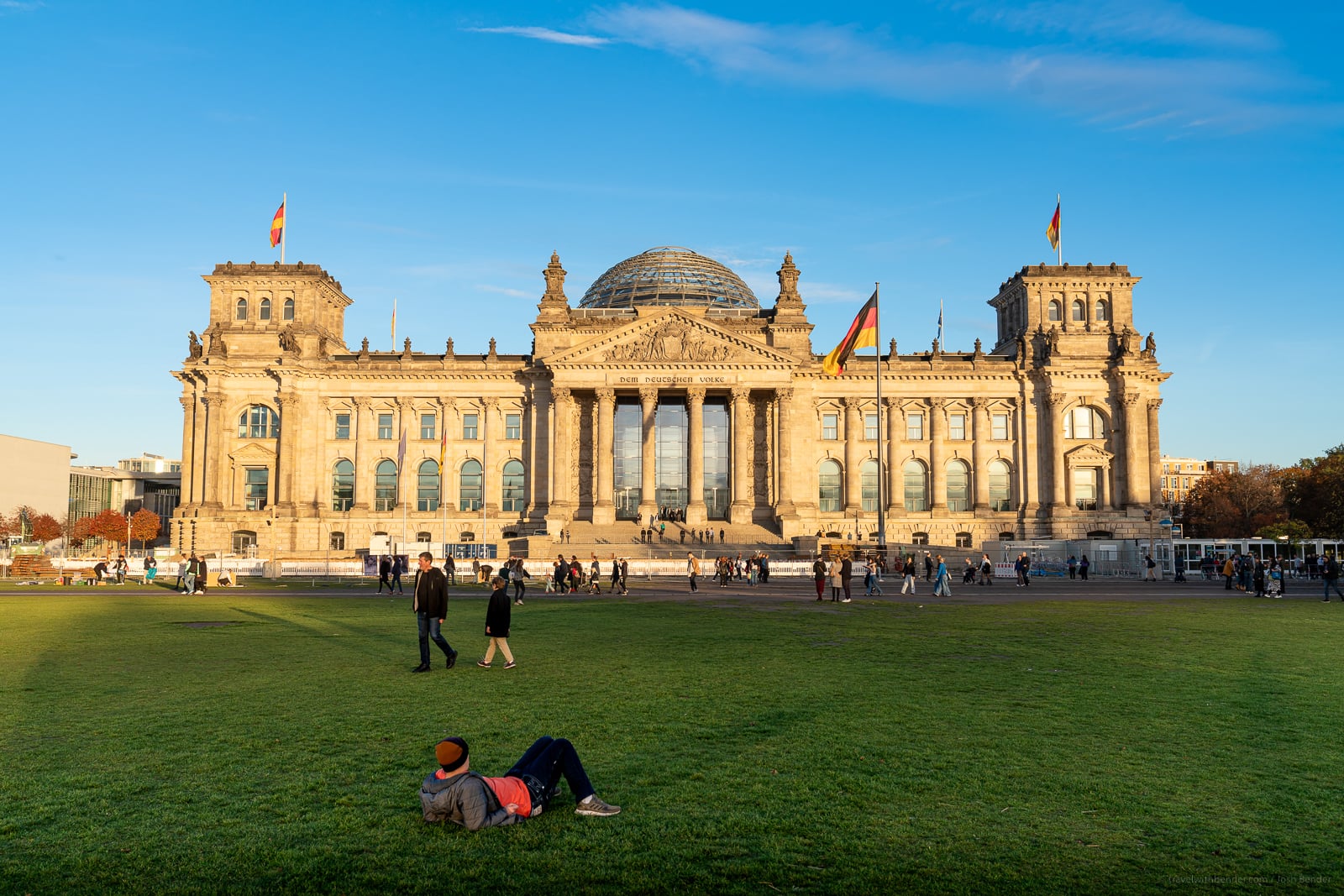
Museum Island
Museum Island is a must-visit for any art and culture lover. Situated in the heart of Berlin, this unique complex boasts 5 world-class museums, each with its own fascinating exhibits and collections:
- Pergamon Museum - classical antiquities (the most visited museum in Berlin)
- Bode Museum – sculptures (from Middle Ages to 19th century)
- Neues Museum - Egyptian exhibits, including the bust of Nefertiti
- Alte Nationalgalerie – paintings and sculptures from Classicism to the Early Modern Age
- Altes Museum – classical antiquity (the first museum building on the island)
All you need to do is grab a map and start your journey through history, art, and culture.
Tip: The Museum Pass is the most economical way to see all the exhibits with one low entry fee.
East Side Gallery (Berlin Wall)
This free open-air gallery is the longest preserved stretch of the Berlin Wall. Covered in colour-soaked murals, these works of art are a powerful reminder of the city's tumultuous past, as well as a celebration of its resilience and creativity. 118 artists from 21 countries contributed to this large-scale art project. Whether you're a history buff or simply looking for one-of-a-kind photo opportunities, the East Side Gallery is definitely worth a visit.
Berlin Wall Memorial
Located in the heart of Berlin, this historic site offers a sobering look into the realities of life during the Cold War era. The memorial features a preserved section of the wall, as well as informative exhibits and displays that offer insights into the wall's construction, its impact on Berlin and the world, and the events that led to its eventual fall. It's a great opportunity to learn more about this important chapter in history and pay your respects to those who suffered.
Memorial to the Murdered Jews of Europe
This sombre monument serves as a potent reminder of the atrocities inflicted on Jews during World War II. The memorial consists of 2,711 concrete slabs arranged in a grid pattern, creating a maze-like atmosphere that inspires quiet contemplation. Slowly strolling along undulating paths between the blocks is a deeply moving experience. The quietness soon makes way for an overwhelming sensation of awe at the scale of crime against humanity. You won’t leave the same.
Tip: Also, visit the underground information centre, which provides an in-depth history of the Holocaust and its impact on Germany and the world.
Topography of Terror (Topographie des Terrors)
Built on the former location of the Gestapo headquarters, the SS central command and the Reich Security Main Office, this museum shares a sobering yet essential perspective on one of Germany’s darkest chapters. While the scale of terror and persecution inflicted across Europe can be difficult to grasp, personal stories shared by all involved, from survivors to oppressors, make the visit personal and relatable. The only way humanity can avoid making the same mistakes is by learning from the past. And this museum plays a crucial role in shaping the next generation.
Checkpoint Charlie
This former border crossing point served as a symbol of the division between East and West during the Cold War. Today, visitors can see a replica of the famous guard house and learn about the history of this important site at the nearby museum.
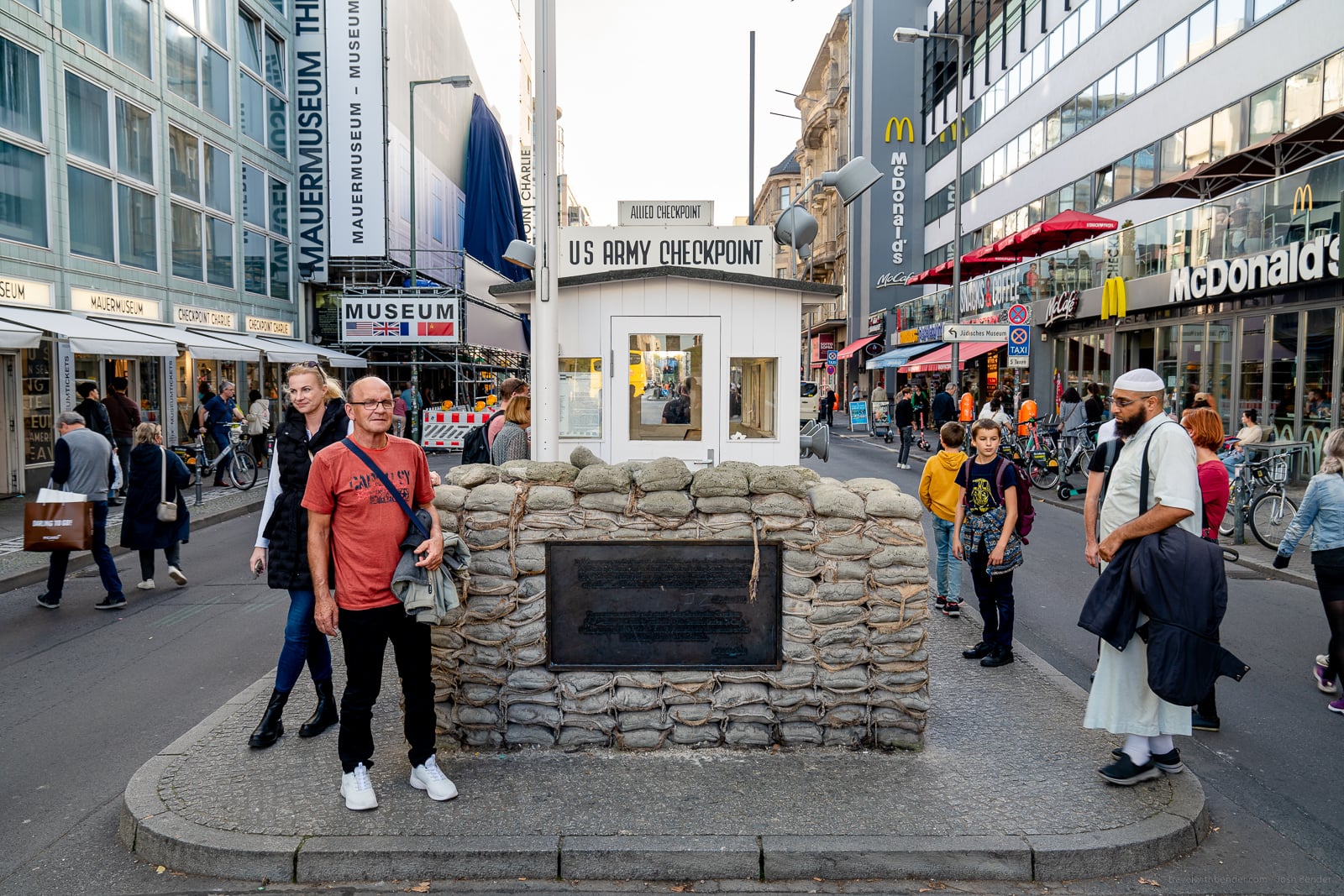
Alexanderplatz
The geographical centre of Berlin is a bustling square lined with boutiques, an ornate Neptune-inspired fountain, gothic church, underground train station, cinema, and town hall. And there’s no shortage of restaurants within walking distance.
Berlin Television Tower (Fernsehturm)
Completed in 1969, this tower is a symbol of modern Berlin, instantly recognisable worldwide. Standing 365 metres in height, it offers visitors a stunning 360-degree view of the city from the observation deck.
Tip: The tower can get quite crowded, so it's best to book your tickets in advance to avoid long queues.
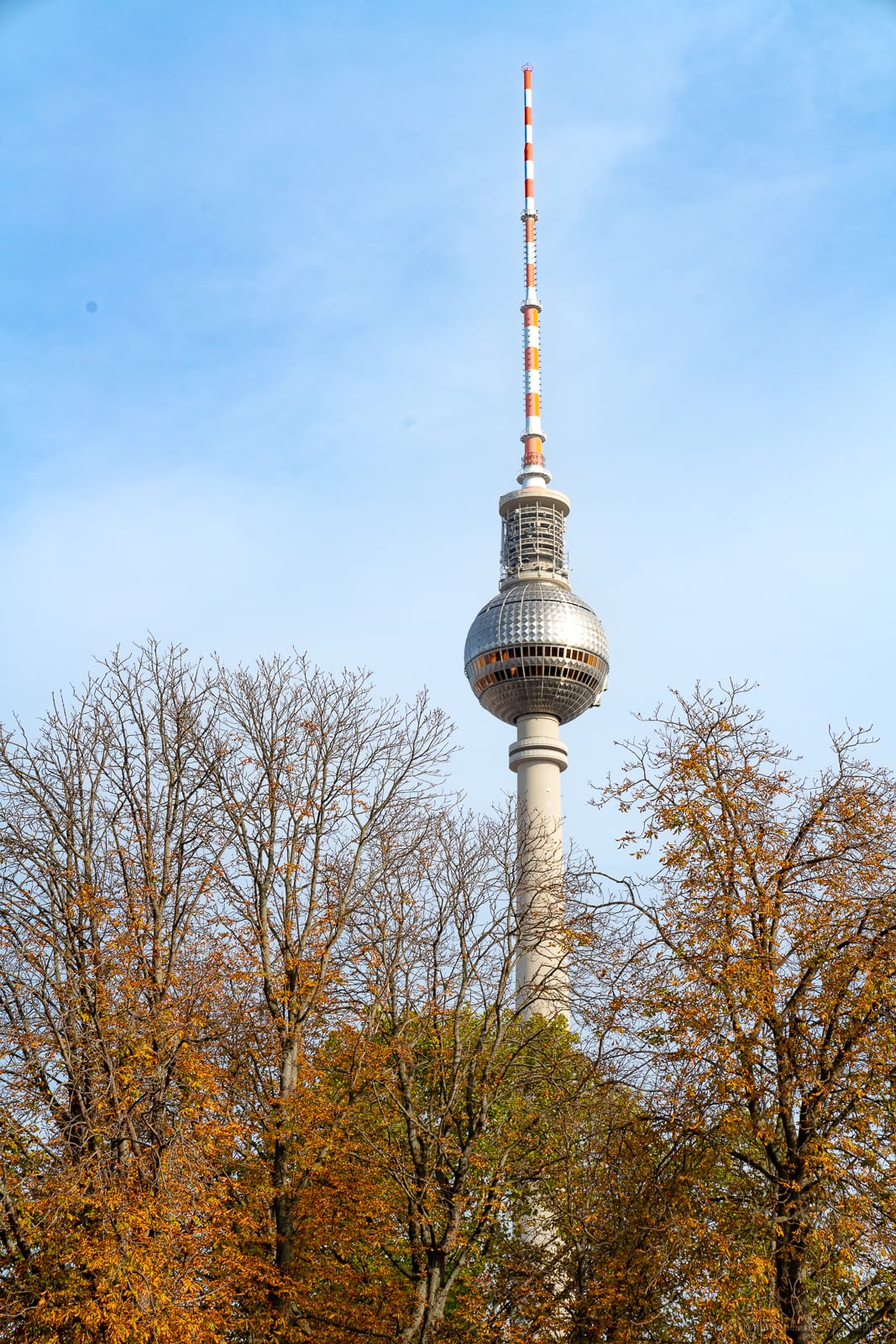
Nightlife
From the iconic Berghain nightclub with sky-high entry requirements, to quaint beer gardens, Berlin has it all. Most well-known nightclubs are renovated abandoned factories, power stations, and office buildings, giving them a post-funk industrial grunge feel. It pays to plan your night in advance, especially if the venue is full or the bouncer turns you away. Check out ra.co for the latest events coming up in Berlin.
Teledisko
This is the world’s smallest disco. 3 locations are scattered around Berlin, named by colour – white, blue and gold. I visited the white location near East Side Gallery. Just deposit €2, choose your favourite song from a touchscreen, and step inside. Buttons control lights and a smoke machine. It’s the most fun I’ve had for €2!
Gendarmenmarkt
An 18th-century paved town square sandwiched by the architectural marvels of Französischer Dom (French Cathedral) and Neue Kirche (German Cathedral) – both protestant cathedrals built in the early 18th century – along with the ornate Konzerthaus.
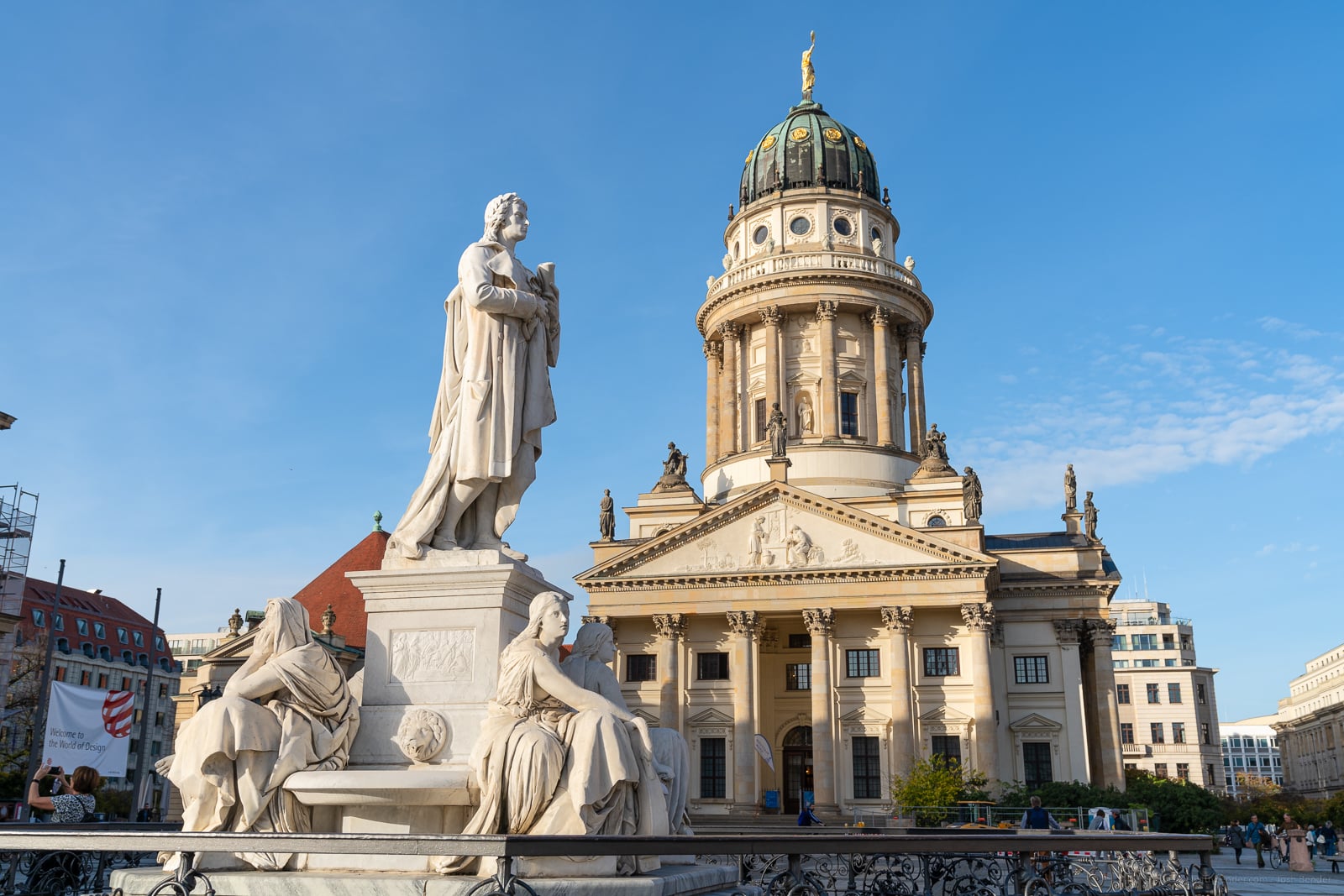
Futurium
If you're a fan of science and technology, the Futurium is for you. This modern museum is dedicated to exploring the future of humanity and technology through interactive exhibits and displays. From artificial intelligence to sustainability, the Futurium offers a glimpse into the innovations that will shape our world in the years to come. The museum is designed to be accessible to all ages, with plenty of hands-on exhibits that encourage curiosity and experimentation.
Dead Chicken Alley
This outdoor art gallery, lined with spraypainted walls, is a 15-minute walk from the famous Alexanderplatz. While the address 39 Rosenthaler Str might seem straightforward, finding it is quite a challenge and half the fun. The origins date to the Nazi era when there was no freedom of expression, so a small group bought the alley so they could paint whatever they wanted.
Disgusting Food Museum
Are you curious about the weirder side of culinary culture? This museum explores the world of culinary oddities, showcasing some of the most controversial and stomach-churning foods from around the globe. From fried tarantulas to fermented shark meat, visitors are in for a wild ride as they navigate the exhibits.
Essential Food to Try in Berlin
One of my biggest expectations for Berlin was the vegan food scene. I had heard so many good things about it, I was a little apprehensive I might be setting the bar too high. But Berlin did not fail. In fact, every single meal was a touchdown. I had to restrain myself from standing up mid-meal and dancing like a wide receiver who’d just scored the match-winning point.
Yes, that good.
It’s best to make restaurant bookings to avoid disappointment, especially for dinner.
At the risk of not sounding like a proper travel blogger, I loved the melting pot of international cuisine in Berlin even more than the local fare. But there are still a lot of German dishes you must try at least once (or twice).
Currywurst
A fast-food staple found almost everywhere. Traditionally, it’s made with pork and a hint of curry (thus the name), and eaten with curry powder and ketchup. Typically it’s sliced for easy eating on the go alongside a dollop of steaming french fries.
Vegans, don’t despair! I found many fast food stores offered vegan versions too. I tried a delicious meat-free alternative at Hauptbahnhoftrain station and Curry at the Wall Berlin Mitte.
Bratwurst
What? Another sausage?! This one originates from two competing regions of Germany (they still can’t decide): Thüringen and Franconia. With evidence proving it’s been around for at least 600 years, and maybe longer, the humble “brat” is part of the fabric of Germany. Made from pork or, less commonly, beef or veal, it can be used as a street food snack, pub dish, or main meal (with sauerkraut) in a German restaurant. For an authentic taste, don’t forget to dip it in mustard. Over 40 varieties exist in all combinations of shape, thickness, colour, and flavour.
Kartoffelpuffer
Authentic snack-sized German potato pancakes made with fried potatoes combined with shredded potatoes, onions, baking powder, and flour, then topped with applesauce. A match made in heaven. Found in street food stalls and Christmas markets.
Bretzels
A doughy knot-shaped savoury snack. Bretzles is the German word for ‘pretzels’, but this variation is slightly fluffier than the original and comes in a range of flavours like cheese or chocolate. It can be found in bakeries, cafes and street food vendors. And don’t be fooled into thinking you can just add “b” in front of any word to make it Berlin-specific. I tried that, and it didn’t work.
Spätzle
Originating from the Swabia region near Stuttgart, this dish is Germany’s take on pasta. The dough is made from eggs, flour, salt, and a dash of soda water. Typically it’s served with a mountain of cheese. Vegan versions can be found as well.
Schnitzel
Heralding from Vienna, this dish has made its way into the hearts of Germans. Traditionally made with pork or veal, it can also be found in chicken or beef alternatives. It’s served with either boiled potatoes, French fries or German Spätzle alongside a slice of lemon and lingonberry jam. Suggested restaurant: Schnitzelei Mitte.
Craft Beer
This is a crucial part of Berlin’s culture that can not be overstated. There are over 5,000 beers across Berlin, so you’ll be spoilt for choice. Found in bars, pubs, and beer gardens. Or my personal favourite method of sampling… a pub crawl.
Donuts
The local variety is called Berliner Pfannkuche or “Berliner” for short. Similar to other filled donuts, it contains hot jam (or other types of fillings like chocolate or cream) and is topped with powdered sugar. Found in bakeries and supermarkets.
I fell in love with Brammibal's Donuts, a vegan-friendly donut chain with 7 locations around Berlin. It’s like dying and going to heaven… without the dying part.
Beyond the German, here are a few vegan-friendly restaurants I can recommend: Chay Viet Berlin (Vietnamese), Miss Vegan Restaurant (Vietnamese), +84 (Vietnamese), Secret Garden (sushi), Esra (Lebanese), Julian & Elisa (ice cream), and Dolores Mitte (Mission-style burrito).

Extra Tips for First-Time Visitors to Berlin
Pick A Side
The vibes are very different depending on the area of Berlin:
- West - upmarket, shopping haven, family-friendly
- Central - commercial, government, tourist-centric
- East - artsy, gritty, nightclubs
Whichever side you choose will depend on the type of vacation you want in Berlin. There really is something for everyone. Of course, you can travel freely throughout the entire city, but if you choose accommodation near the areas you want to explore the most, it will save a lot of time in transit.

Plan Your Nightlife
Expect to wait in long queues for nightclubs – up to an hour or two is normal. And have a few plan B’s in case you’re not let in. Check what time the trains stop running (see above under “public transport”), otherwise you might be left wandering around a platform at 4am (ahem, yeah, it happened to a friend of mine).
Language
Most Berliners are well-educated and speak a moderate amount of English. Reading signs in German is a case of what-you-see-is-what-you-say (unlike English!), which is great for non-German-speaking tourists. However, as a sign of courtesy, it pays to learn a few basic phrases in German. Make sure you download offline translations in the Google Translate app. The “audio transcribe” tool may save the day – you never know.
Stay Connected
Pick up a SIM card (or eSIM), so you’re connected to the Internet – don’t rely on jumping between insecure public WiFi hotspots. Read my article for more info on eSIMs in Europe. I used a SIM from Holafly with unlimited data, to stay connected all over Europe. It was my lifeline in Berlin.
Navigate Like A Pro
I highly recommend the mobile app Citymapper (iOS, Android) rather than Google Maps for navigating the public transport network. The live arrival times help to avoid wasting time standing at a bus or metro stop, when you could be cruising the Spree River or strolling through another museum.
Do Your Research
German history goes back thousands of years (including the Holy Roman Empire, Prussia and modern Germany), and to really grasp modern Berlin, it pays to understand its backstory. Check out these series, movies, and documentaries:
Netflix: Barbarians, The Empress, Greatest Events of WWII in Colour, All Quiet on the Western Front.
YouTube: a YouTube video playlist of 13 vids.

Where to Stay in Berlin
Berlin is split into 12 districts. On your first visit to Berlin, you should allow at least 4 days to see all the major attractions, although 5-6 days might be a more comfortable pace. The 5 most common areas for tourists to stay are:
Charlottenburg-Wilmersdorf (west) – home to the most famous shopping street in Berlin, Kurfürstendamm, and the legendary department store Kaufhaus des Westens (KaDeWe). Other nearby attractions include Berlin Zoo, Kaiser Wilhelm Memorial Church, Bikini Berlin shopping centre, photo gallery C/O Berlin, and convention centre Messe Berlin. There’s not a lot in the way of nightlife, so this area is well-suited for family-friendly travellers.
Mitte (central) – this is the closest thing Berlin has to a “downtown”. Well-connected via public transport, it’s easy to explore the whole city from a central base. Food and hotels are a little pricier, but it’s home to some of the biggest tourist drawcards: Reichstag Building, Brandenburg Gate, and Museum Island. I stayed here.
Kreuzberg (central) – We’re getting more into Berlin’s alternative culture scene. Things are a little rougher than Mitte and Charlottenburg-Wilmersdorf, but you’ll be spoilt with oodles of cute bars and restaurants. Hotel options are fewer, but it’s cheaper than Mitte, and closer to the nightlife hub in the city’s east.
Friedrichshain (east) – if you could describe this area in one word, it would be “diversity”. Bars around Boxhagener Platz are packed, but just a few streets away, you’ll find peace and quiet. Check out the Sunday flea market for an assortment of bargains. Due to the nightclubs and bars, some streets can be loud at night, so if you’re a light sleeper, keep that in mind.

Neukölln (east) – Fewer international tourists stray here, so it’s less crowded on trains. The legendary nightlife is the main drawcard, but there’s more than just nightclubs. Restaurants draw on inspiration from all corners of the globe, especially the Middle East. Tempelhofer Feld is a public park converted from a former airport. While Britzer Garten draws on English inspiration and features the largest sundial in Europe (99 metres in diameter).
That’s A Wrap!
After spending 4 months in Europe, covering 31 cities in 16 countries, I can confidently say Berlin will be the first place I visit next time I come to Europe. And for a guy who’s been to 70+ countries, that’s no small compliment. I’ve had a taste of the vibe, and I want more.
If you’ve read this far, you really don’t need any more convincing – you’re just looking for ways to make your trip to Berlin as smooth as butter. And I hope this guide will serve you well.
It takes a little planning and preparation to get the most out of Germany’s capital, but it’s definitely worth it.
And when you leave, you’ll be like me, daydreaming about the next time you return to Berlin.
It’s not a matter of “if” but “when”.













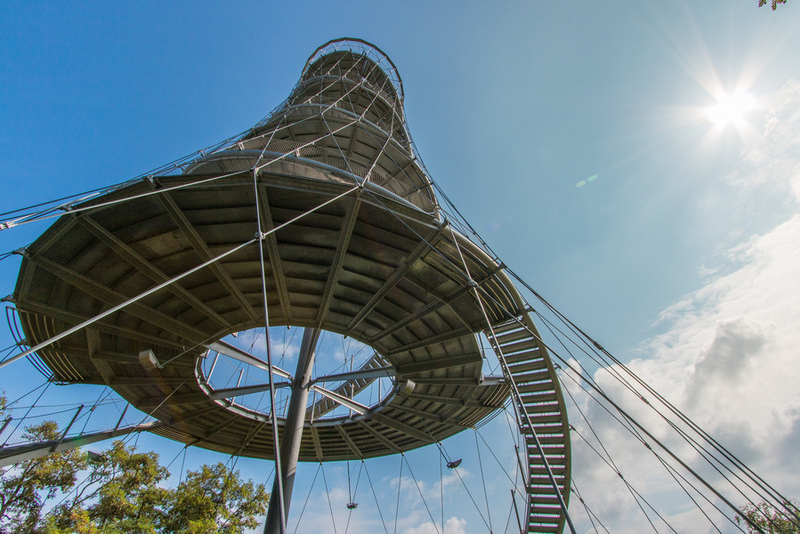
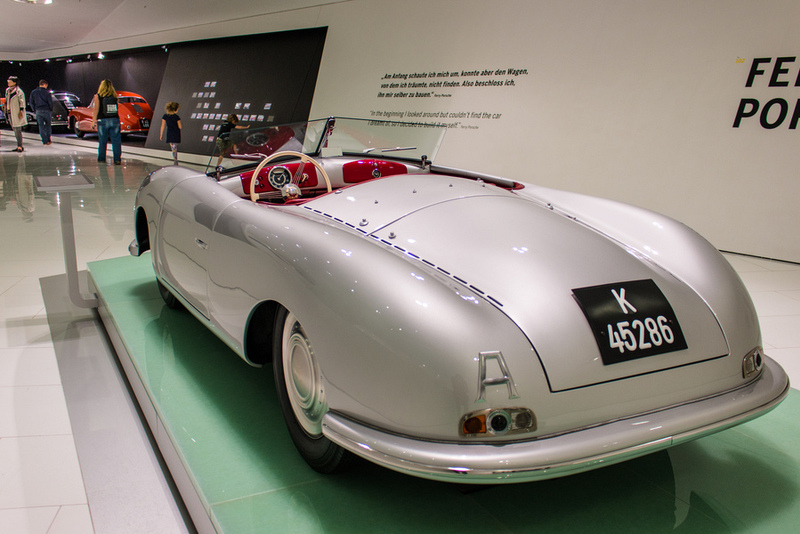

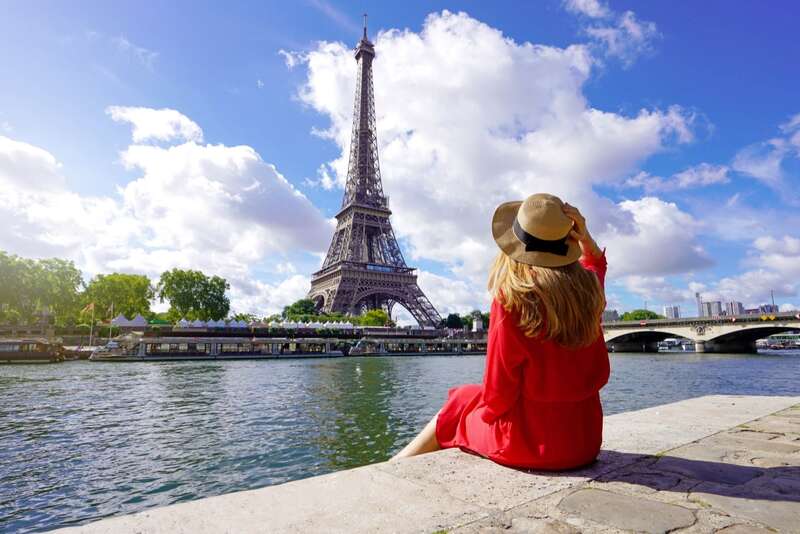

Reader Comments...
"I respond to every comment by direct private email. I look forward to your feedback" - Josh BenderThanks for sharing this with us. Keep up the great work, Josh!
I read this post your post so nice and very informative post thanks for sharing this post
Write Your Comment
Please DO NOT include links, URLs or HTML in your comments - they will be automated deleted and you will waste your time.